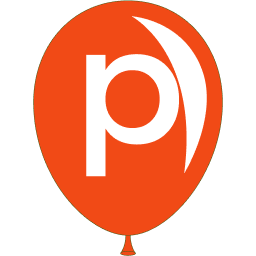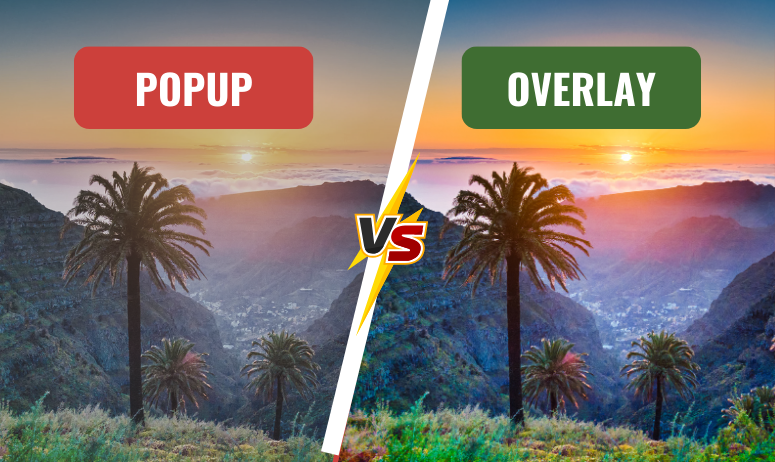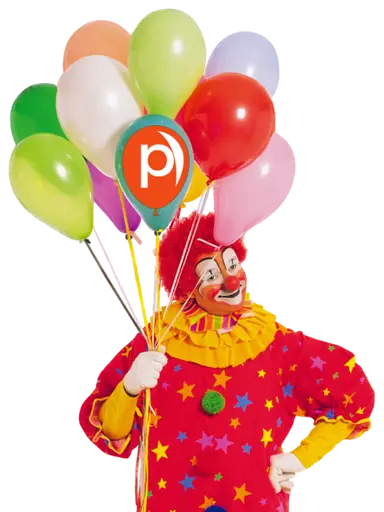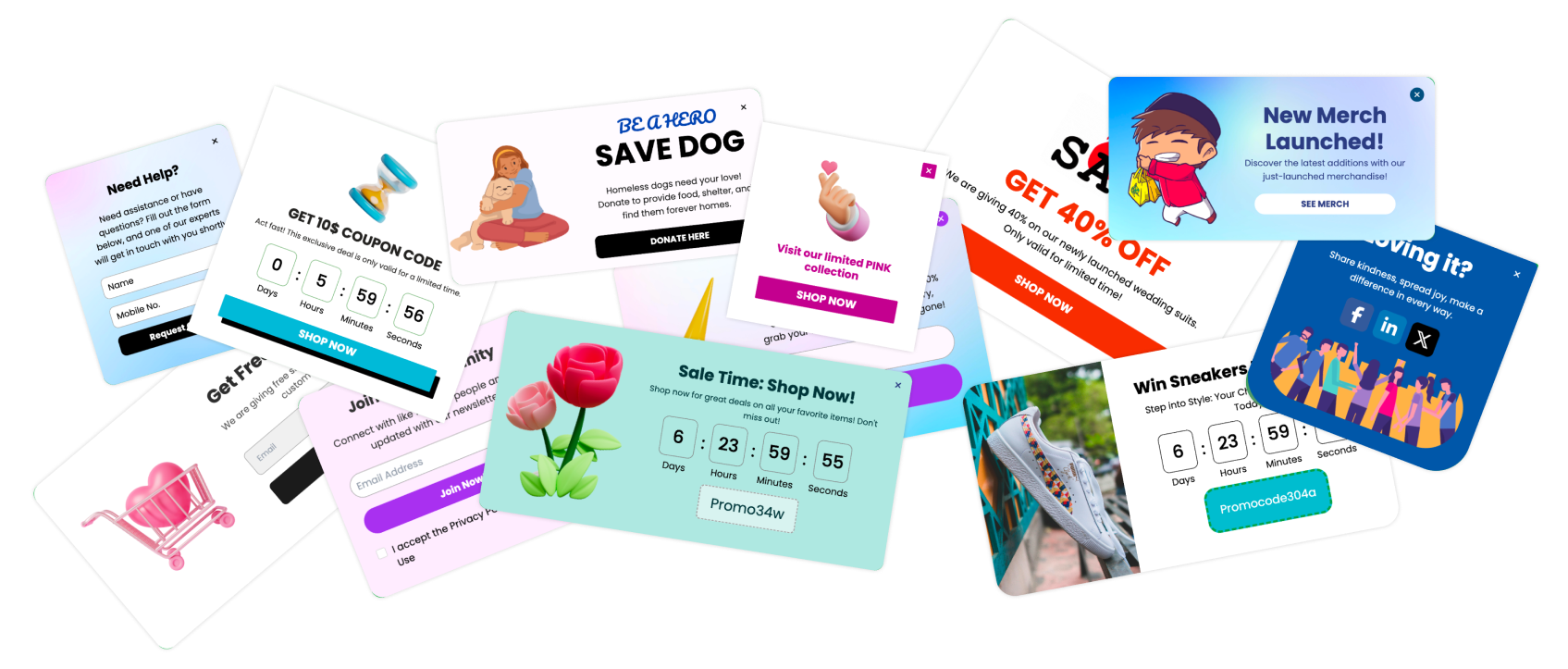Introduction
Popups and overlays are essential elements in modern web design, helping businesses engage users, drive conversions, and provide important information. However, they are often confused with each other. While both serve as interactive elements that appear over the main content, their functionality, impact on user experience, and implementation differ significantly.
"Good design is obvious. Great design is transparent." – Joe Sparano
In this guide, we will explore the differences between popups and overlays, their specific use cases, best practices, and how to leverage them effectively without negatively impacting user experience.
What Are Popups and Overlays?
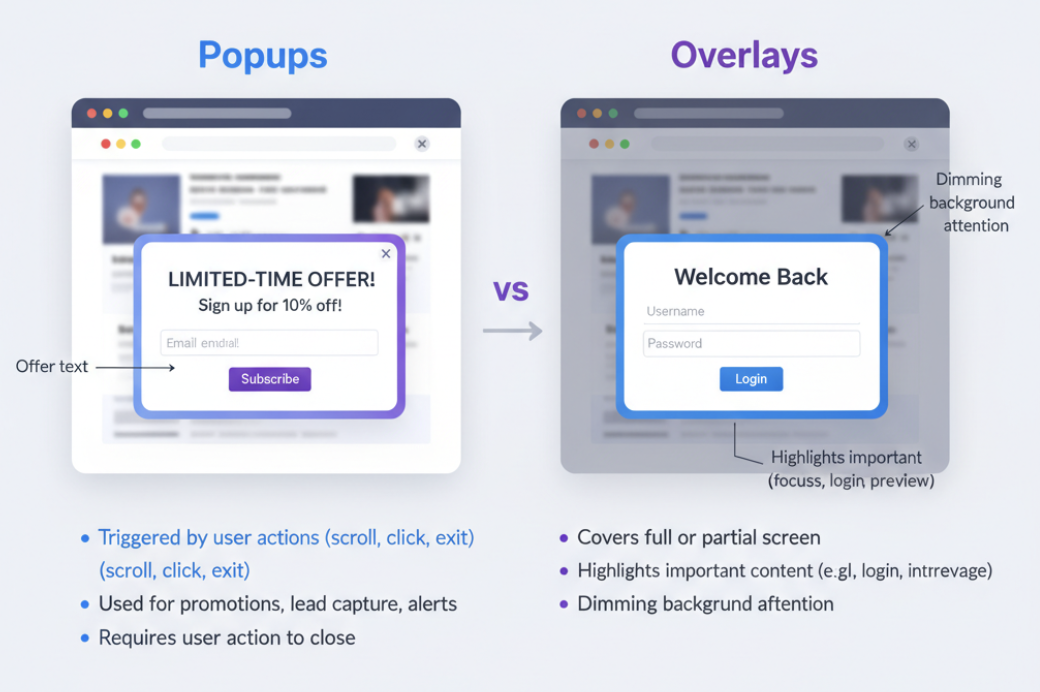
Defining a Popup
A popup is a small window that appears over the main content of a webpage, usually triggered by a specific user action such as clicking, scrolling, or exiting the page. Popups are commonly used for:
Collecting email subscriptions
Displaying promotional offers
Providing important alerts or notifications
Characteristics of Popups
| Feature | Description |
|---|---|
| Appearance | Small floating box over the main content |
| Trigger | User actions (scroll, click, exit intent, etc.) |
| Purpose | Lead generation, promotions, notifications |
| Interaction | Requires user action to close or proceed |
Popups are widely used in marketing and engagement strategies to capture visitor attention and encourage specific actions.
Defining an Overlay
An overlay, on the other hand, is a semi-transparent or fully opaque layer that covers part or all of a webpage. Overlays are often used to emphasize specific content or features without completely interrupting the browsing experience.
How Overlays Differ from Popups
Overlays are often larger and can cover the entire screen, whereas popups are usually smaller windows.
Overlays are used to highlight content such as login forms, product previews, or lightbox image displays.
They create a dimming effect on the background, keeping the user’s focus on the overlay content.
Typical Use Cases for Overlays
| Use Case | Example |
|---|---|
| Image Lightbox | Enlarging images in a gallery |
| Modal Dialogs | Login prompts, alerts |
| Interactive Forms | Newsletter subscriptions, feedback forms |
Types of Popups and Overlays
Now that we understand the key differences between popups and overlays, let's explore the different types of each and how they can be used effectively.
Common Types of Popups
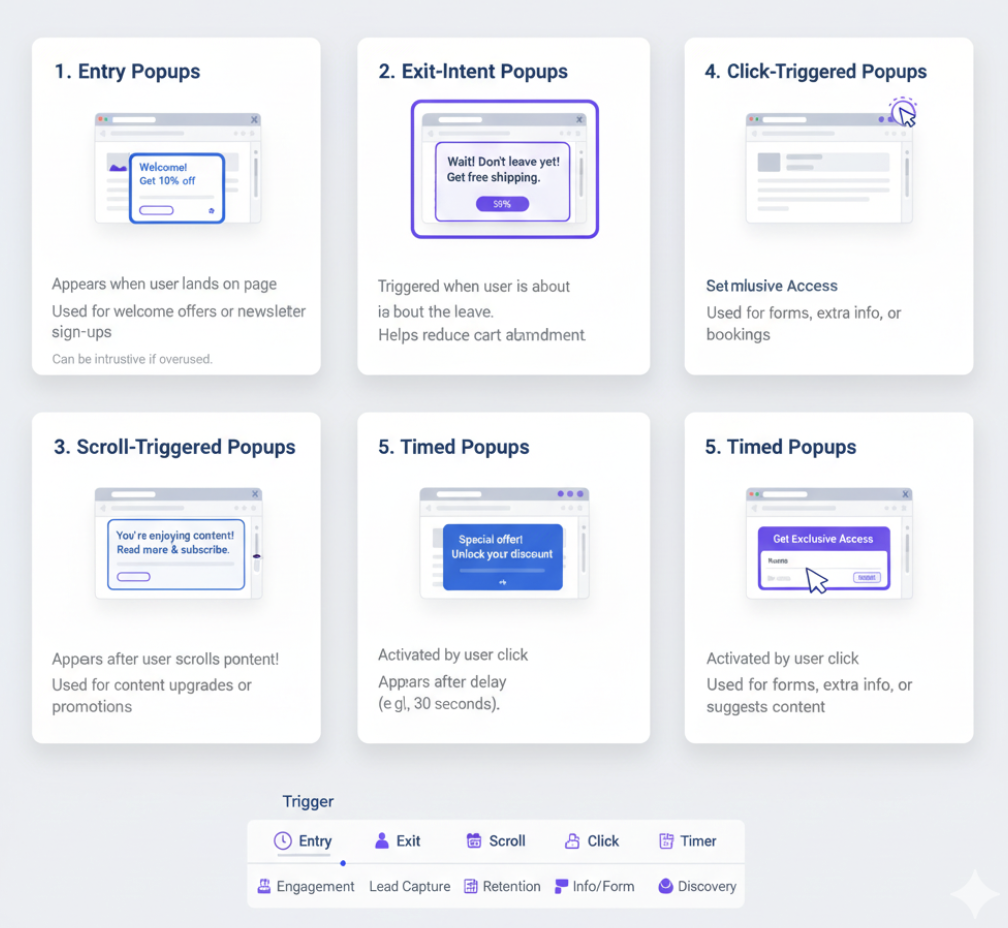
Popups come in various forms, each designed for specific user interactions and conversion goals.
1. Entry Popups
Appear as soon as a user lands on a webpage.
Used for welcome messages, discount offers, or newsletter sign-ups.
Can sometimes be intrusive if not designed properly.
2. Exit-Intent Popups
Triggered when a user is about to leave the page.
Great for capturing leads or preventing cart abandonment.
Works by tracking mouse movement towards the browser's close button.
3. Scroll-Triggered Popups
Appear when a user scrolls a certain percentage of the page.
Helps in engaging users who are already invested in the content.
Commonly used for content upgrades or promotional messages.
4. Click-Triggered Popups
Activated when a user clicks on a specific element (e.g., button, link, or image).
Used for lead generation forms, additional product details, or appointment bookings.
5. Timed Popups
Displayed after a user spends a specific amount of time on a page.
Useful for offering discounts, capturing emails, or suggesting related content.
Common Types of Overlays
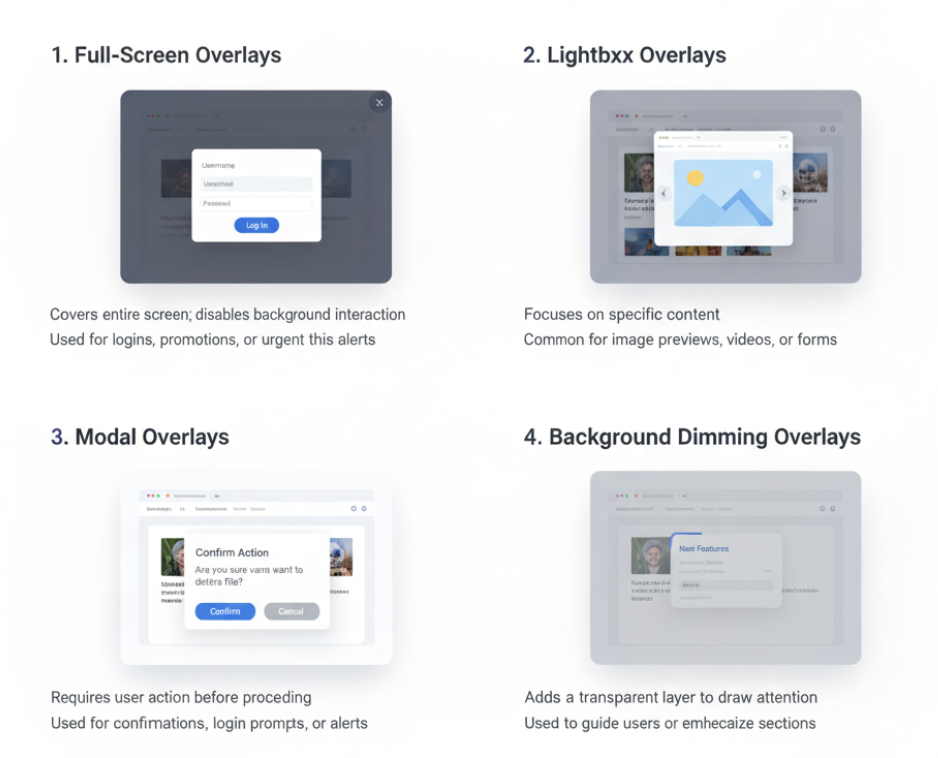
Overlays enhance user experience by providing additional content without completely interrupting navigation.
1. Full-Screen Overlays
Cover the entire screen, temporarily disabling background interactions.
Used for login pages, promotions, or important announcements.
2. Lightbox Overlays
Focus on a specific element while dimming the background.
Commonly used for image previews, forms, or video popups.
3. Modal Overlays
Require user interaction before they can proceed.
Used for confirmation dialogs, login forms, or important notices.
4. Background Dimming Overlays
Keep the page visible while adding a transparent layer over it.
Helps in drawing attention to a specific section without blocking content.
| Popup Type | Best Use Case |
|---|---|
| Entry Popups | Welcome discounts, sign-ups |
| Exit-Intent Popups | Lead capture, cart recovery |
| Scroll-Triggered | Content upgrades, offers |
| Click-Triggered | Forms, product details |
| Timed Popups | Engagement, email collection |
| Overlay Type | Best Use Case |
|---|---|
| Full-Screen Overlays | Promotions, announcements |
| Lightbox Overlays | Image previews, videos |
| Modal Overlays | Forms, confirmations |
| Background Dimming | Subtle content emphasis |
Benefits of Using Popups and Overlays
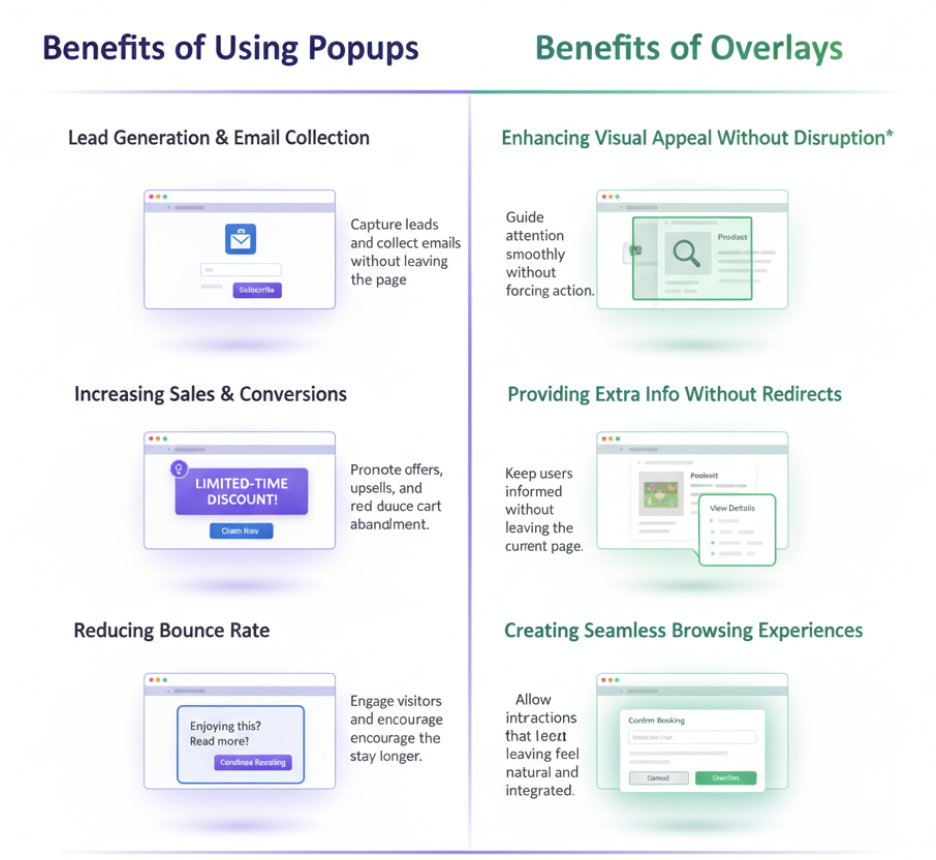
Both popups and overlays serve crucial roles in web design, offering unique advantages that can significantly impact user engagement and conversions. Let’s explore the specific benefits of each.
Benefits of Popups
Popups, when used correctly, can be a powerful tool to drive conversions and capture user attention.
1. Lead Generation and Email Collection
Popups are widely used for collecting email subscribers and generating leads.
Forms embedded in popups encourage users to sign up without navigating away from the page.
Exit-intent popups can recover potential lost leads by offering exclusive incentives.
2. Increasing Sales and Conversions
Popups can promote special discounts, limited-time offers, and upsells.
They provide an opportunity to directly engage with potential buyers at crucial moments in their journey.
Exit-intent and cart abandonment popups help reduce lost sales by offering incentives to complete the purchase.
3. Reducing Bounce Rate
Timed and scroll-triggered popups can retain users by providing relevant content suggestions.
Encourages users to stay longer on the site by offering helpful resources or engagement tools like quizzes, guides, or downloadable content.
Benefits of Overlays
Overlays enhance user experience by providing important information without being overly intrusive.
1. Enhancing Visual Appeal Without Disrupting Content
Overlays allow for smooth, visually appealing interactions that blend seamlessly with the user journey.
Background dimming overlays subtly guide user attention without forcing them to take immediate action.
2. Providing Additional Information Without Redirecting Users
Overlays help display additional product details, tooltips, or instructions without requiring a full page refresh.
Lightbox overlays improve content consumption by keeping the user within context.
3. Creating a Seamless Browsing Experience
Unlike popups, overlays don’t always require immediate action, allowing for better user flow and engagement.
Modal overlays can be used for forms, sign-ups, or confirmations, ensuring that users stay focused on the main task.
| Benefit | Popups | Overlays |
|---|---|---|
| Lead Generation | ✅ Yes | ❌ No |
| Sales & Conversions | ✅ Yes | ❌ No |
| Reducing Bounce Rate | ✅ Yes | ❌ No |
| Enhancing Visual Appeal | ❌ No | ✅ Yes |
| Providing Extra Info | ❌ No | ✅ Yes |
| Seamless Experience | ❌ No | ✅ Yes |
Best Practices for Popups and Overlays
To maximize the effectiveness of popups and overlays, it’s essential to follow best practices that enhance user experience, minimize disruption, and improve conversions.
Design Considerations
1. Choosing the Right Colors, Fonts, and Sizes
Popups and overlays should align with your website’s branding and color scheme to maintain consistency.
Use contrasting colors for CTA buttons to make them stand out.
Keep fonts legible and clear, ensuring readability on all devices.
2. Ensuring Mobile Responsiveness
Many users browse on mobile devices, so popups and overlays must be optimized for different screen sizes.
Use mobile-friendly designs, avoiding excessive text or images that may clutter the screen.
Ensure that popups do not obstruct navigation elements like menus or back buttons.
User Experience Optimization
1. Avoiding Intrusive or Frustrating Designs
Google penalizes intrusive popups, so ensure they do not disrupt the primary user experience.
Use non-intrusive overlays that provide value rather than force an action.
2. Adding Easy-to-Find Close Buttons
Users should be able to close popups and overlays effortlessly.
Always provide a visible “X” button or “No, thanks” option to improve usability.
Timing and Triggering Strategies
1. When and How to Display Popups vs Overlays
Entry popups should be used cautiously to avoid overwhelming visitors.
Exit-intent popups work well for capturing leads before users leave.
Timed popups should appear only after users have spent a few seconds on the page.
Overlays can be triggered by user actions like clicking a button or hovering over an element.
2. A/B Testing Different Trigger Types
Test different timing, triggers, and messaging to determine the most effective popup or overlay strategy.
Analyze engagement metrics such as click-through rates, conversion rates, and bounce rates to optimize performance.
| Best Practice | Popups | Overlays |
|---|---|---|
| Mobile Responsiveness | ✅ Yes | ✅ Yes |
| Non-Intrusive Design | ❌ No | ✅ Yes |
| Easy-to-Close Feature | ✅ Yes | ✅ Yes |
| A/B Testing Recommended | ✅ Yes | ✅ Yes |
| Google Penalty Risk | ✅ High | ❌ Low |
Common Mistakes to Avoid
Even with best practices in place, businesses often make mistakes when implementing popups and overlays. Avoiding these pitfalls can help maintain a positive user experience and maximize engagement.
Using Too Many Popups or Overlays
Problem: Bombarding users with multiple popups or overlays can frustrate them and lead to higher bounce rates.
Solution: Limit the number of popups and overlays per session and only show them when necessary.
Making It Difficult to Close Popups and Overlays
Problem: If users struggle to find the close button, they may leave the website entirely.
Solution: Ensure that every popup and overlay has a clearly visible close button, ideally at the top-right corner.
Slowing Down Page Speed with Heavy Scripts
Problem: Poorly optimized popups and overlays can slow down your website, impacting both user experience and SEO rankings.
Solution: Use lightweight scripts and ensure that popups load asynchronously to prevent delays.
Ignoring Mobile Optimization
Problem: If popups and overlays are not mobile-friendly, they may cover essential content or make navigation difficult.
Solution: Test all popups and overlays on mobile devices and ensure they adjust seamlessly to different screen sizes.
Not Offering Value to Users
Problem: Popups and overlays should not feel like interruptions but should offer meaningful content or incentives.
Solution: Provide clear value through exclusive offers, helpful content, or personalized recommendations.
Violating Compliance Regulations
Problem: Failing to adhere to GDPR and CCPA guidelines can lead to legal issues.
Solution: Always provide a clear opt-in option for data collection and respect user preferences.
| Common Mistake | Impact on User Experience | Solution |
|---|---|---|
| Too Many Popups | High Bounce Rates | Use them sparingly |
| Difficult to Close | Frustration, Site Abandonment | Clearly visible close button |
| Heavy Scripts | Slow Page Speed, SEO Issues | Optimize loading time |
| Poor Mobile Experience | Navigation Issues | Test on mobile devices |
| No User Value | Low Engagement | Provide incentives |
| Compliance Violations | Legal Risks | Follow GDPR/CCPA rules |
Case Studies: How Brands Use Popups and Overlays Effectively
Examining real-world applications of popups and overlays can help businesses implement them strategically. Here are some case studies of brands that have successfully used these elements to enhance engagement and conversions.
Case Study 1: E-Commerce Brand Boosting Sales with Exit-Intent Popups
Brand: Fashion Retailer XYZ
Challenge: High cart abandonment rate.
Solution: Implemented exit-intent popups offering a 10% discount to users about to leave.
Result: 25% increase in completed purchases.
Key Takeaway: Exit-intent popups can recover lost sales by providing incentives at the right moment.
Case Study 2: SaaS Company Using Overlays for Product Tours
Brand: SaaS Tool ABC
Challenge: Low user engagement and onboarding completion.
Solution: Introduced an interactive overlay guiding new users through key features.
Result: 40% improvement in onboarding completion rates.
Key Takeaway: Overlays can enhance user experience by providing contextual assistance without interrupting workflow.
Case Study 3: Media Website Increasing Subscriptions with Timed Popups
Brand: News Portal DEF
Challenge: Low newsletter subscription rate.
Solution: Displayed a timed popup after 30 seconds, prompting users to subscribe.
Result: 15% increase in newsletter sign-ups.
Key Takeaway: Timing popups correctly ensures they capture user interest without being intrusive.
Case Study 4: Service-Based Business Improving Lead Generation with Click-Triggered Popups
Brand: Digital Marketing Agency GHI
Challenge: Low conversion rate on service inquiry pages.
Solution: Used click-triggered popups to offer a free consultation when users clicked on a CTA button.
Result: 30% increase in lead form submissions.
Key Takeaway: Click-triggered popups are effective because they appear based on user action, making them highly relevant.
Case Study 5: E-Learning Platform Enhancing User Engagement with Lightbox Overlays
Brand: Online Course Provider JKL
Challenge: Users abandoning video lessons midway.
Solution: Implemented lightbox overlays suggesting related courses when a video ended.
Result: 20% increase in course enrollments.
Conclusion and Final Thoughts
Choosing between popups and overlays depends on your website’s goals and user experience priorities. Both elements play a crucial role in engagement, conversions, and guiding users through the digital journey, but their implementation must be strategic.
FAQs: Answering Common Questions
Which is better for conversions, popups or overlays?
Both can be effective depending on usage. Popups work well for lead generation and direct CTAs, while overlays enhance user engagement with contextual information.
Do popups hurt SEO rankings?
Google penalizes intrusive popups, especially on mobile. Ensure your popups follow SEO best practices, such as providing value and easy dismissibility.
Are overlays less intrusive than popups?
Yes. Overlays typically blend into the page and provide information without completely blocking content, making them less disruptive than popups.
How can I make popups and overlays more user-friendly?
Use clear exit options, proper timing, mobile-friendly designs, and A/B testing to optimize the user experience.
Can I use both popups and overlays on my website?
Absolutely! A balanced combination of popups and overlays can maximize engagement and conversions while maintaining a positive user experience.
